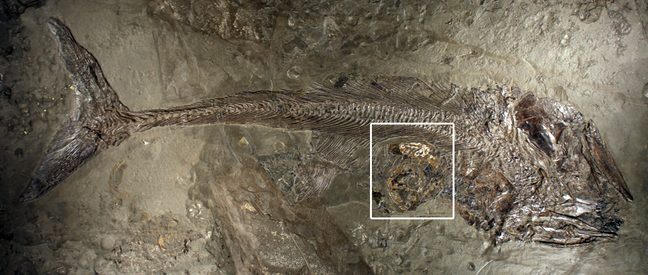A new research paper by Samuel Cooper and Dr Erin Maxwell from the Natural History Museum Stuttgart, describes a unique fossilised specimen of the bony fish Pachycormus macropterus from the Early Jurassic of Germany which choked to death whilst trying to swallow an empty ammonite shell.
The examined fossil consists of the 85 cm long bony fish Pachycormus macropterus, whose gut contains a large ammonite shell. An accidental deposition of the fish on the ammonite shell could be ruled out upon closer examination. The paleontologists found conclusive evidence that the shell is contained inside of the fish’s gut, which indicates a possible and previously only assumed predator-prey relationship.
The ammonite shell is undigested and well-preserved, indicating that the shell was swallowed immediately prior to the fish’s death. The researchers conclude that this unique feeding event was fatal, with the ingestion of the ammonite shell being directly responsible for the fish’s death. Either the shell became trapped in the throat causing the fish to choke and drown, or the sharp edge of the shell tore open the stomach wall causing catastrophic internal bleeding. Either way, it must had been a very unpleasant death.
Paleontologists had previously theorized that ammonites were eaten by fishes during the Mesozoic, but now there is possible evidence to confirm this. It is suspected the shell was swallowed unintentionally, most likely as a consequence of the fish erroneously misidentifying the floating shell for a distressed squid or small fish.
The specimen has been in the collections of the State Museum of Natural History in Stuttgart since the 1970s, but has remained unstudied until now. It is a textbook example for why it is important to re-examine old specimens in museum collections. If you want to make a fantastic discovery in paleontology, you don’t always need to visit a beach of quarry, rather ask to take a look inside the drawers at your local museum.
